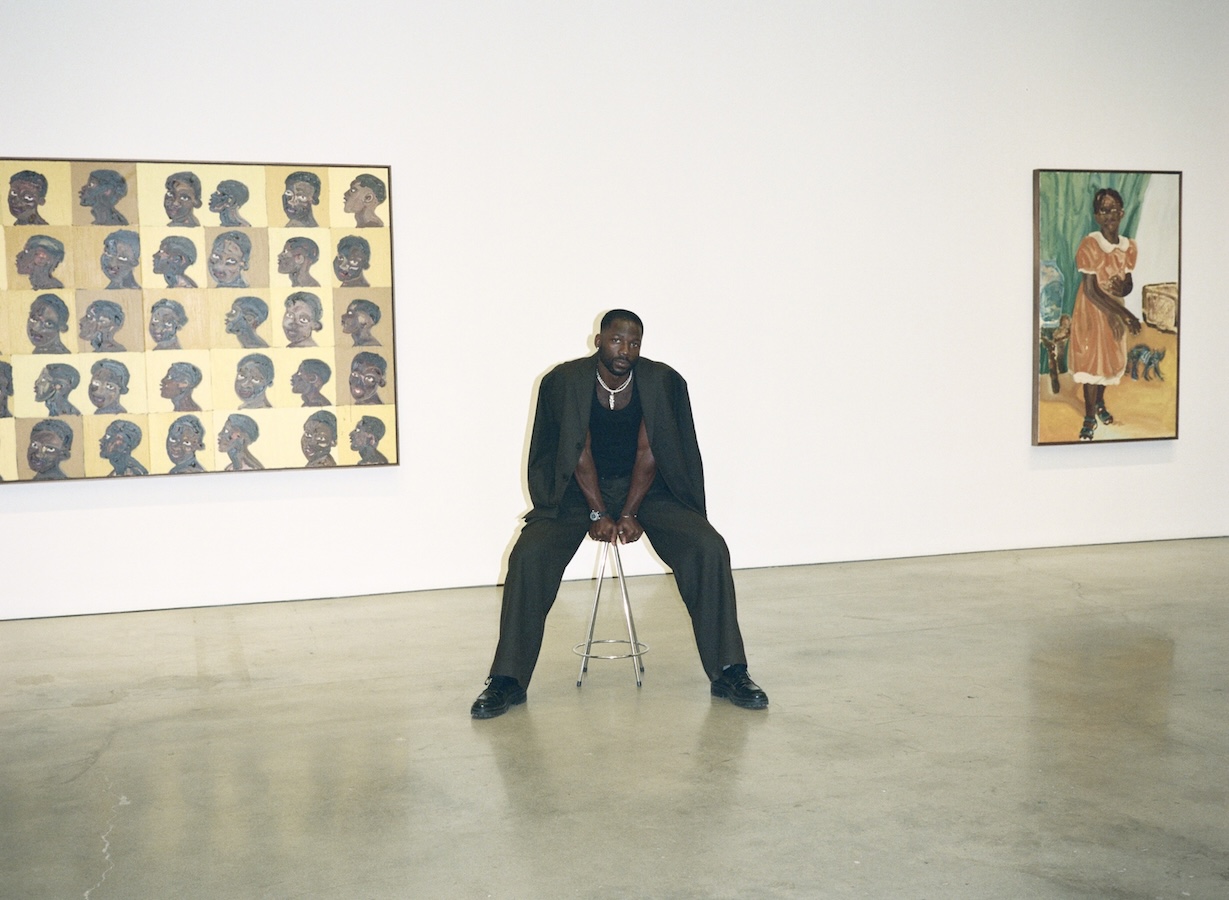Isabel Marant and Arnold Goron have been collaborating since 2007 on the window displays for the French fashion designer’s stores. Initially, Goron worked on Marant’s boutiques in Paris. Today, he makes displays for her 18 stores worldwide. In early October, on the day before her show for her spring/summer 2016 collection, Whitewall sat down to talk to both of them in Marant’s Parisian headquarters. Despite the stress, she and Goron chatted away amiably, cracking jokes and reminiscing about their collaborative experiences.
WHITEWALL: How did the two of you meet?
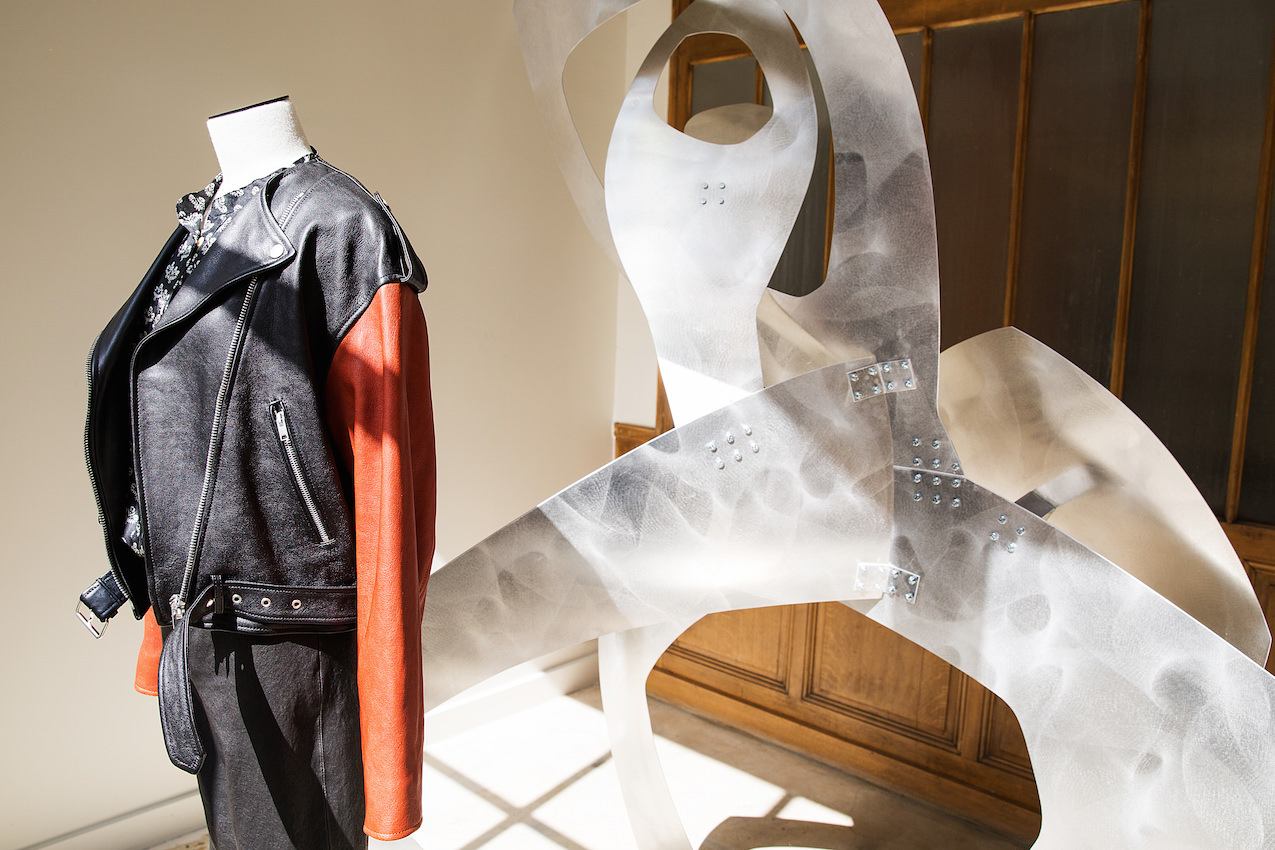
Hanabira Glacées
ISABEL MARANT: We first met amicably. Arnold used to be married to a very good friend of mine.
ARNOLD GORON: At the time I was a graphic designer, but I’d always made sculptures. There was somebody else doing Isabel’s windows, but this person couldn’t manage all of them, and I was asked to share the workload. At the beginning, I didn’t understand anything at all. I was used to making completely flat things as a graphic designer, and, although I’d made sculptures, I’d never made any for window displays. I didn’t realize that you could have fun making real volumes for them. The first windows weren’t superb. It was enjoyable, but I was worried about not being able to find a good idea each time like Isabel does for each catwalk show.
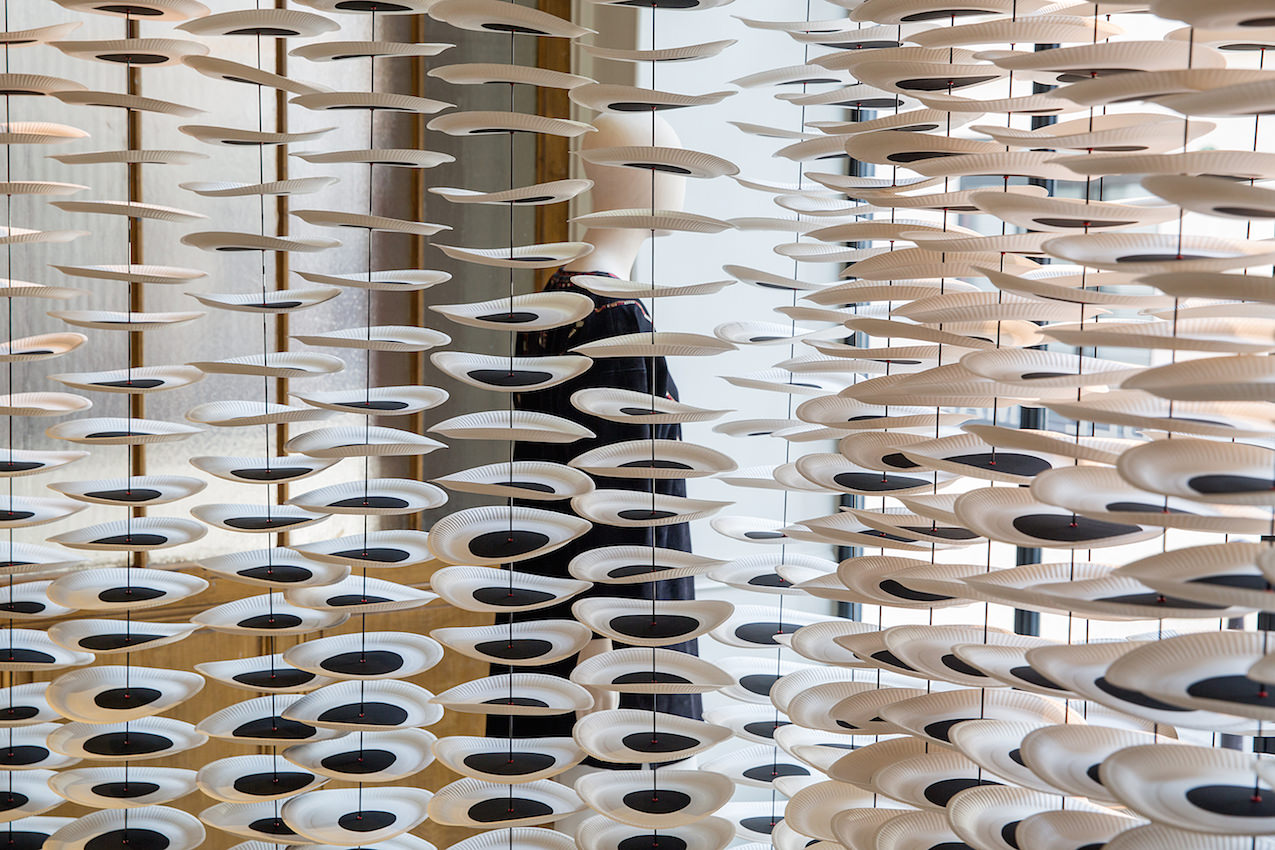
Spinning Plates
By Arnold Goron for Isabel Marant
IM: It’s an enormous amount of work because we change the windows twice a season, so it comes around very quickly. I took a long time to open my first store because I found just doing clothes hard and I wanted to do something else in my stores, too. So I called on different people that had an artistic sensitivity close to mine. Right from the start, we tried to have interesting animation in the windows in order to create a universe around the clothes. I wanted to accentuate the ideas that had been inspirational for my catwalk shows and collections, and share my universe a bit. Meeting Arnold was absolutely perfect because we share the same taste for the same things, so there’s a very natural interactivity between us. Today I only do my windows with Arnold because we hardly need to exchange our views. We bounce inspirations off each other mutually, and it really makes me happy to work like that.
WW: What similarity of vision do you have?
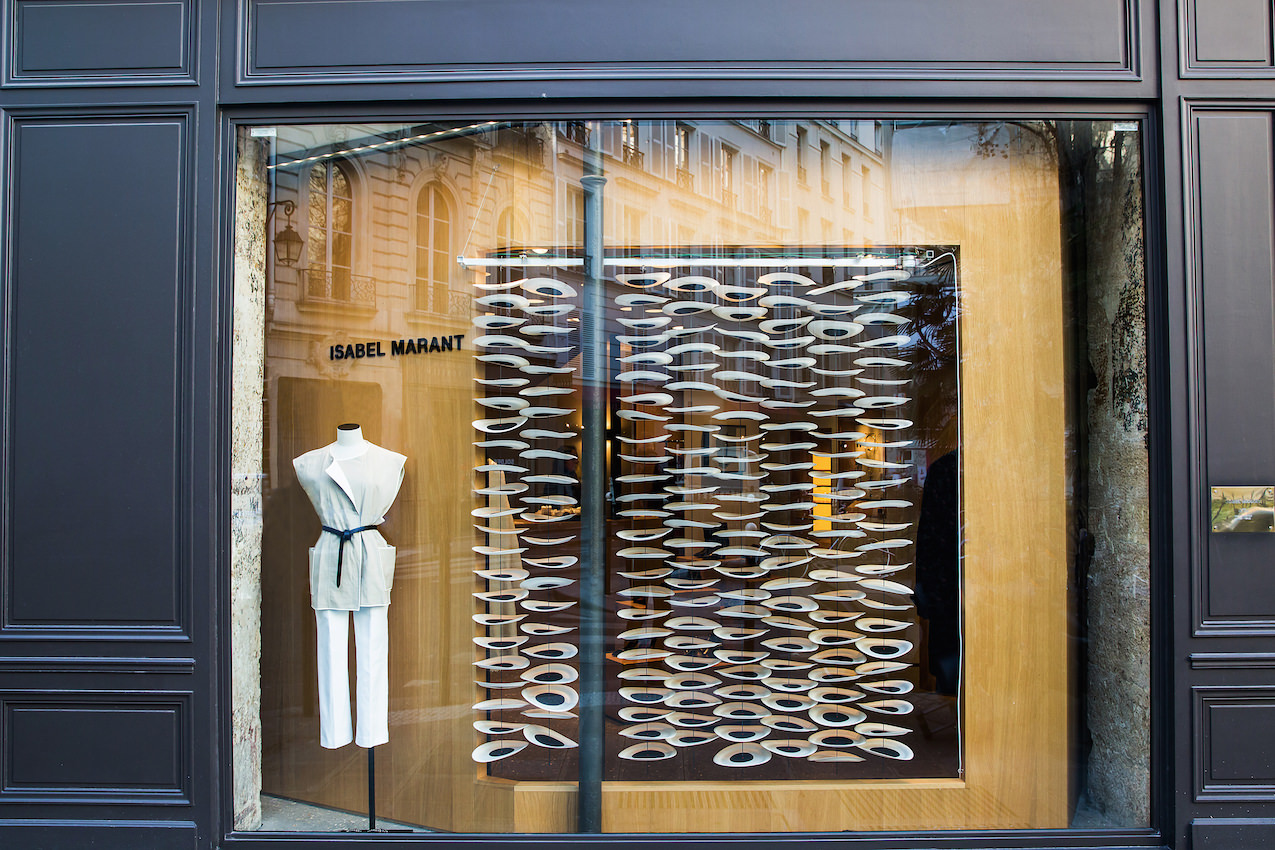
Spinning Plates
By Arnold Goron for Isabel Marant
AG: We both like kinetic art that’s joyful and that moves.
IM: We like having animation because it’s something that attracts someone’s attention when they’re walking down the street.
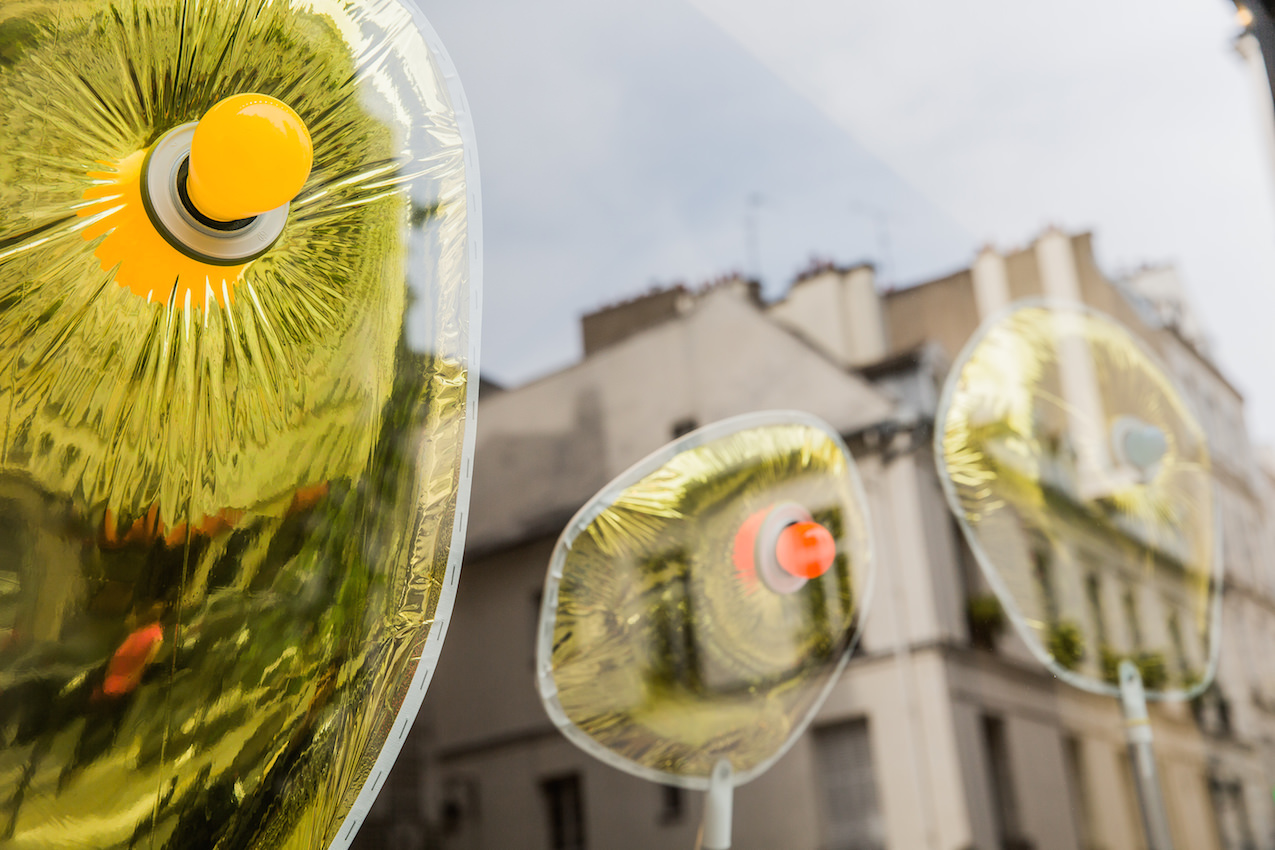
By Arnold Goron for Isabel Marant
AG: We noticed that men like it a lot, too. As they come with their wives, it enables them to look at things turning around, and they usually like the technical side of the installations. I like bringing people into the store who wouldn’t come in normally and maybe one day they’ll buy something.
IM: And we like doing colorful things, especially in winter.
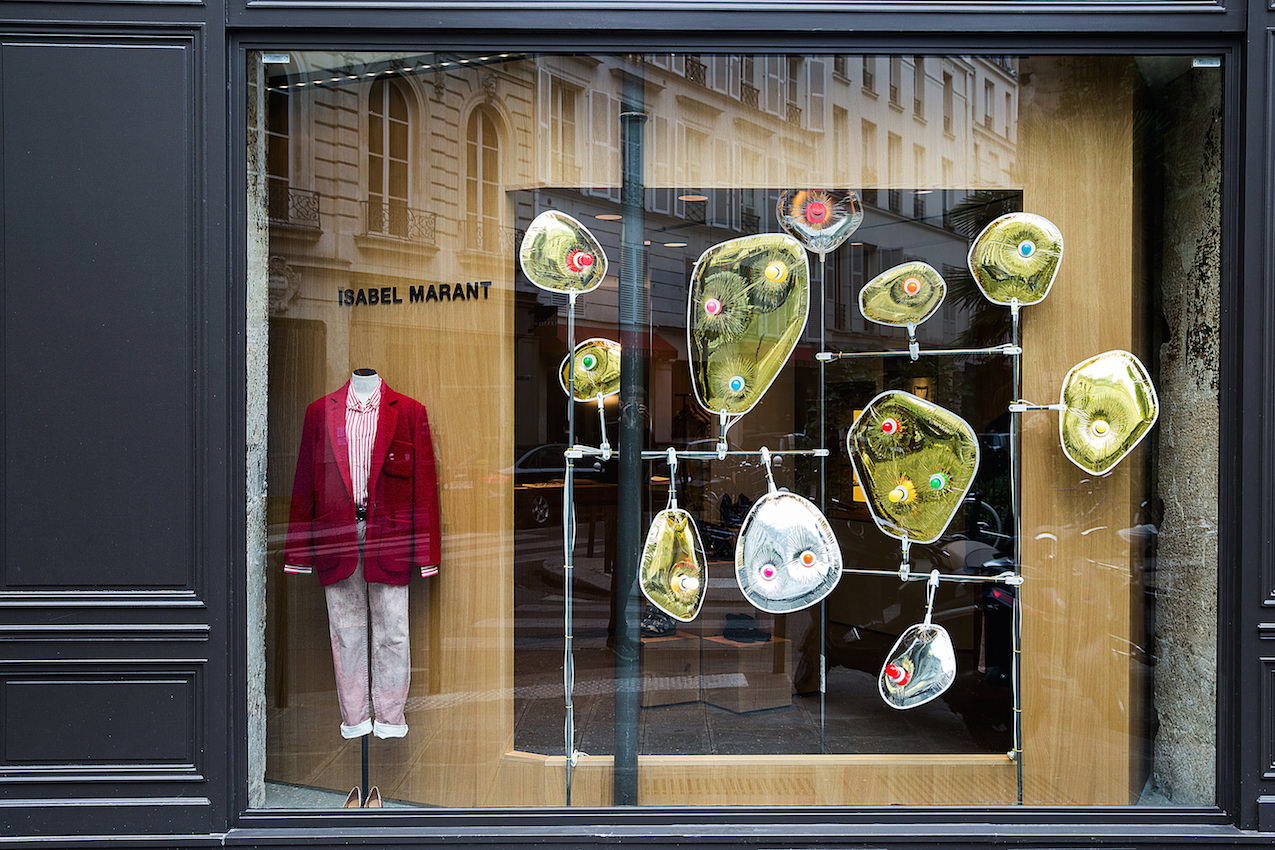
By Arnold Goron for Isabel Marant
AG: Before we used to do a window for Christmas and the idea was to create a shift—thinking about Christmas but not using baubles, tinsel, or a Christmas tree. We did a “Happy Noël” and “Joyeux Christmas” installation with letters on colorful wooden balls spinning around on wooden structures.
IM: Arnold and his ex-wife used to speak a kind of Franglais. We find it funny to mix them up. It’s a way of sharing the lightness of the everyday and having an approach toward fashion that’s less theatricalized than what you often see.
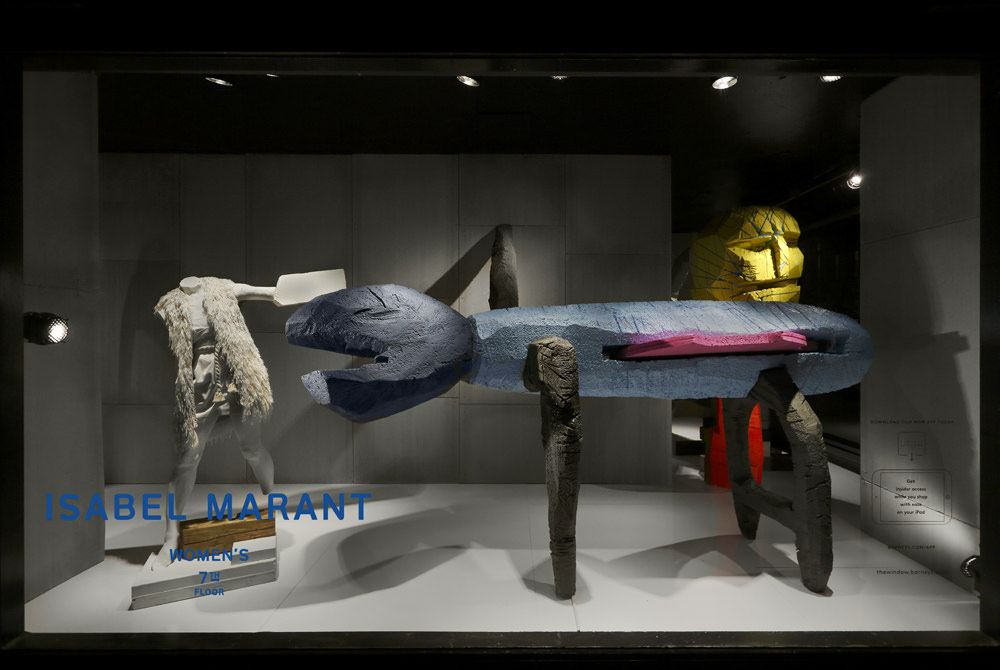
By Arnold Goron for Isabel Marant
WW: Where do you get ideas for the window displays from, Arnold? How do you draw inspiration from Isabel’s collections?
AG: I get ideas mainly from exhibitions. I always find that there’s a link, even a small one, between Isabel’s collection and the windows, but I think this mostly happens by unbelievable chance. By the time Isabel has finished her collection, I already have an idea even if I don’t know exactly what she’s been doing. Then we agree on the colors or materials.
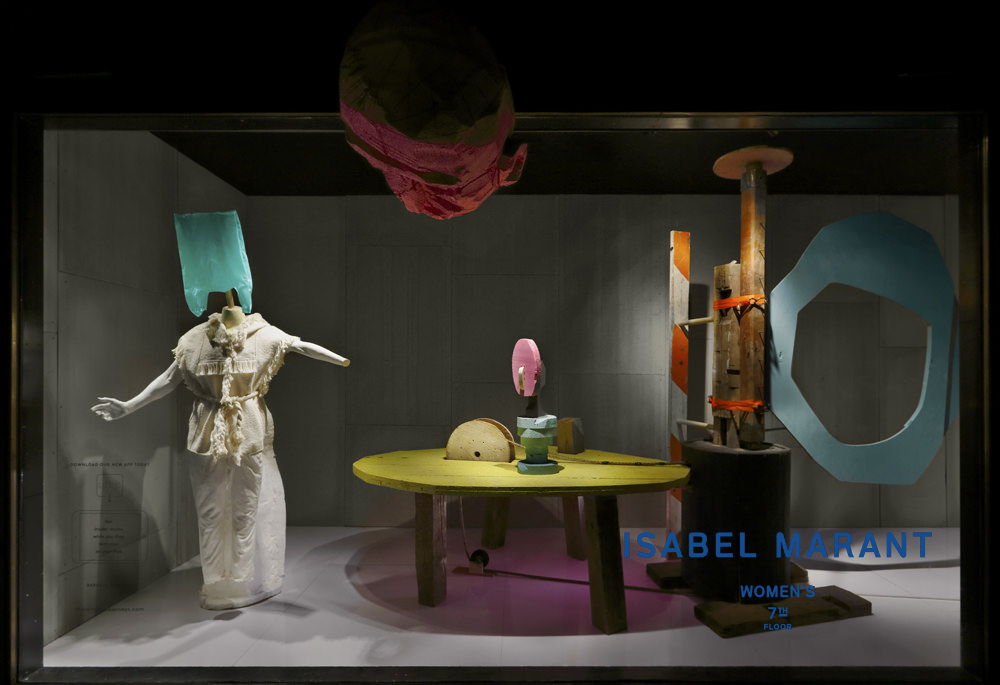
By Arnold Goron for Isabel Marant
IM: It’s quite impalpable because of our common sensitivity. Something Arnold creates might evoke something in one of my collections, but it’s difficult to denote a precise path. It’s very organic. Both us like looking at lots of different things and creating volumes. I have the same approach with my collections—I like diverting fabrics and not showing how they’re made. We both share a love for the artisanal and bringing out the human being behind things. But we both love technology and techniques. It’s a mix of two universes which aren’t perhaps made to meet each other. It’s the clash of things that interests us.
WW: Some of your window installations remind me of Franz West, Thomas Houseago, and Alexander Calder.
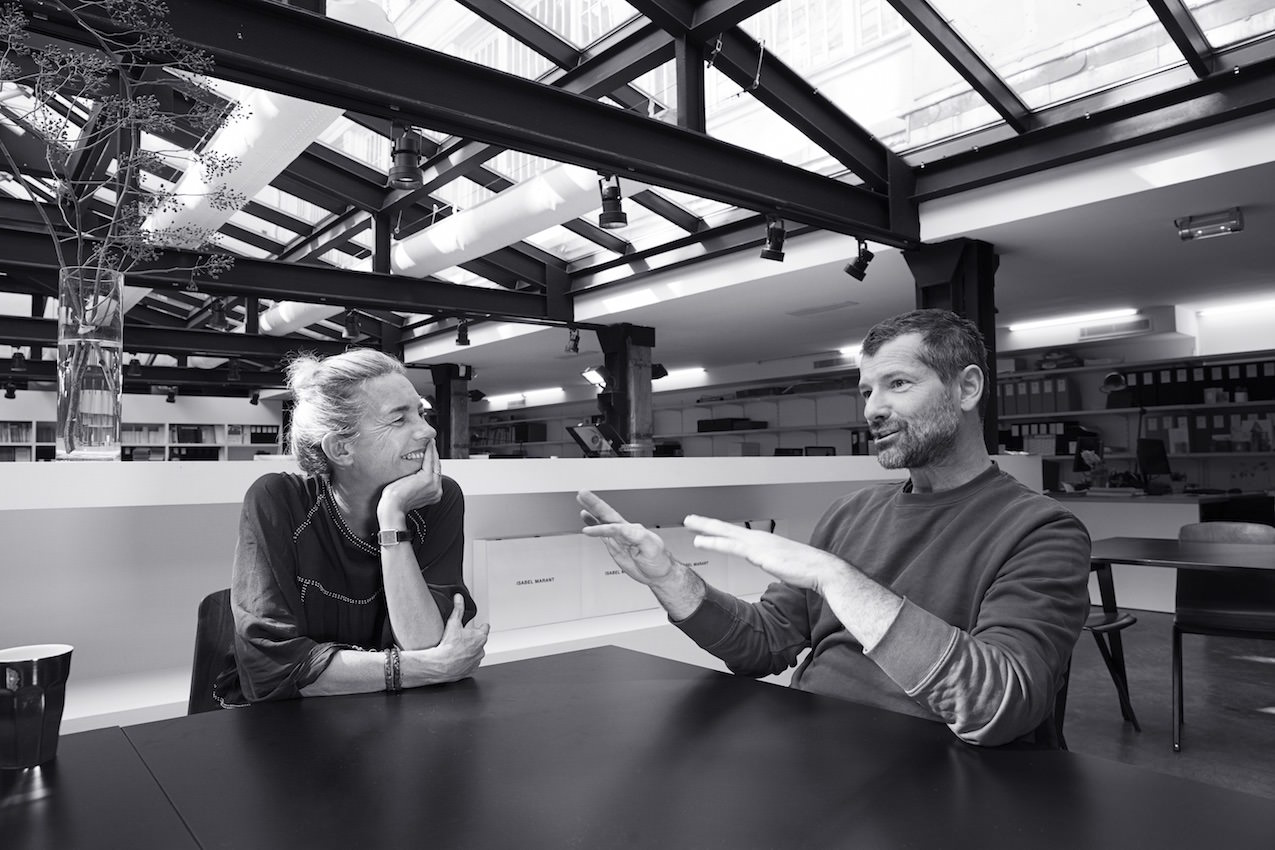
Photo by Robert Lakow
IM: They’re all artists that we adore!
AG: Whenever one thinks about mobiles, one thinks about Calder because he invented them. Thomas Houseago, I love his work.
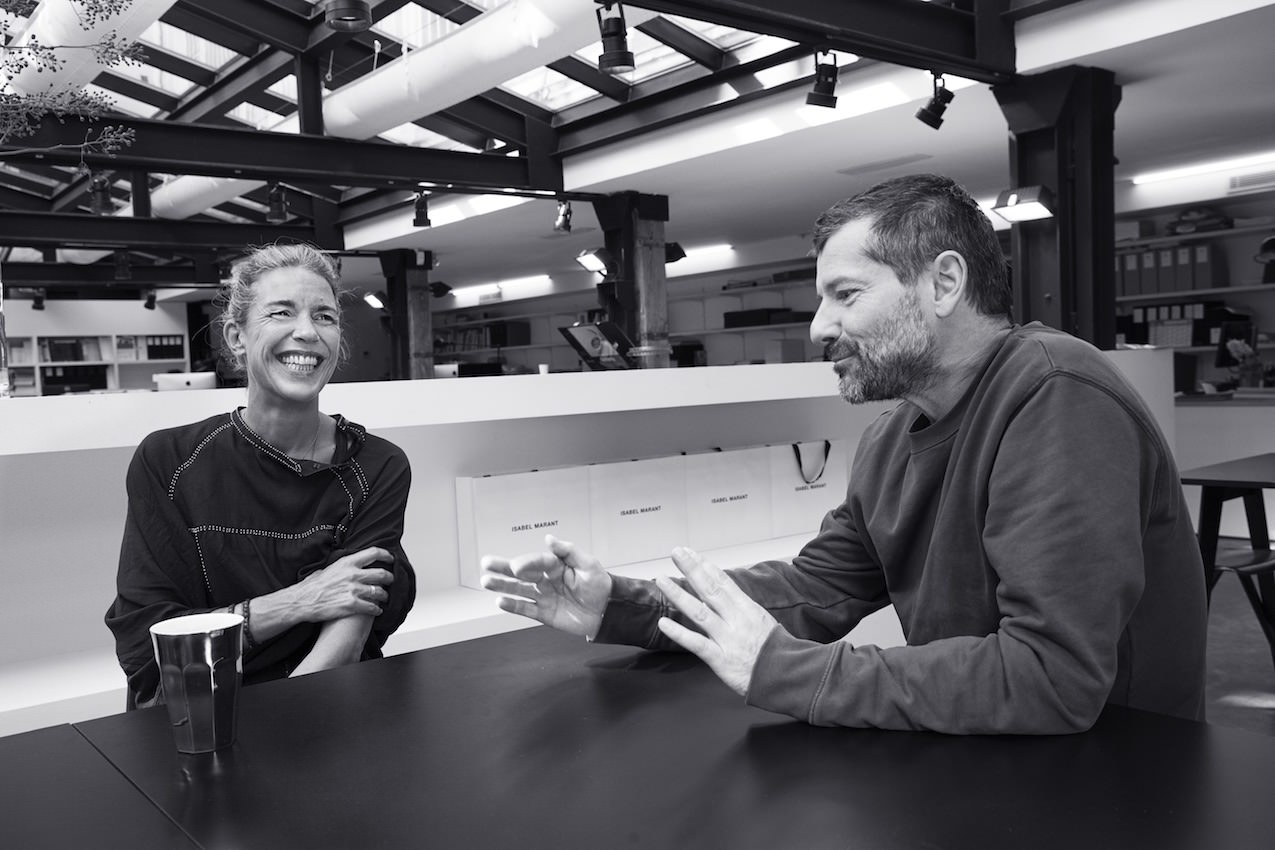
Photo by Robert Lakow
WW: Do you ever go and see exhibitions together?
IM: Not usually. But we went to Donald Judd’s foundation in New York together and were looking at his wooden sculptures, looking underneath the tables to see the quality of the wood and how the pieces were mounted. [Laughter]
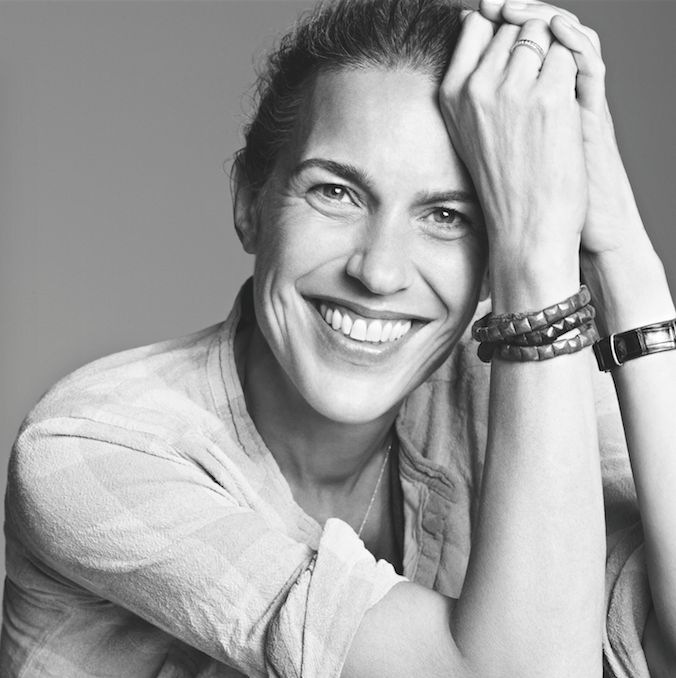
Portrait courtesy of Isabel Marant
WW: Arnold, what are you striving for each time you do a new series of stores for Isabel?
AG: Each time I try to find a new material. Sometimes I come back to the same one, like the survival blankets [used for the gold and silver “Happy Clouds” decorated with ceramic colored bulbs in 2014]. If I make a head, I tend to make it in quite a raw way, like in African art. I’m more at ease with abstract and organic forms. Making sculptures of women is super-hard. So I prefer making big male figures and hands!

Photo by Frederique Dumoulin
WW: Isabel, have you ever indicated to Arnold how you’d like him to draw inspiration from one of your collections?
IM: Not precisely. Arnold discusses a lot with Nathalie [Chemouny], who is in charge of the boutiques. When they’re happy with an idea, I go downstairs—because I work upstairs—for five minutes and say, “Yes, it’s super.” Or, “No, I see it more like this or that.” Sometimes he’ll modify what he’s thought of doing according to what I say, but that’s rare. Or sometimes he arrives with a sketch or inspiration images. But the idea can lead somewhere else entirely when he’s working with the right materials and on the right scale. So they’re more meetings about intentions. Our collaboration depends enormously on the extreme confidence that we have in one another.

Isabel Marant spring/summer 2016
AG: When I tell her what I want to do at the beginning and show her the maquette, she needs to have enormous trust and the imagination to be able to say, “It’s going to be good.” Sometimes they call me to do a pop-up store for the following week. Normally, fashion houses want the window displays one year in advance; here they’re cooked the previous day. I love doing things fast.
IM: Me too, because there’s a spontaneity and an honesty. After finishing my catwalk show, I can’t take any more and need to move onto the next thing. Spontaneity and naturalness give an authenticity to things, whereas if you have too much time and do things over and over again, you think, “Oh, my God.” It’s the beauty of the gesture that’s important.

Isabel Marant spring/summer 2016
WW: Do you follow Arnold’s progress much?
IM: No, not really. I see photos of what he’s working on. But we leave him a lot of liberty. What he does apart from what he does for me interests me enormously. I love the objects that Arnold makes with ceramics and the earth. Sometimes that’s less adapted to the stores because sending objects like that abroad is complicated due to our constraints.

Isabel Marant fall/winter 2015-16
AG: Once we made porcelain birds for the stores in Paris in 2009. Each bird was made with 3,500 feathers and was as fragile as glass. It wouldn’t be possible to do that [for all the stores internationally] today. There’d be too many risks.
WW: Can you describe your approach for making pieces for Isabel’s stores around the world?

Isabel Marant fall/winter 2015-16
AG: I want each window to be unique and specifically adapted to the volumes of each place, which isn’t simple. It’s not like repeating the same module in different sizes and having them made by somebody else. Usually, I make everything in my atelier, although occasionally we have certain pieces cut or made in a factory. Out of the 21 “Hanabi Glacées” [brushed aluminum, abstract sculptures for the fall 2015 windows], the first didn’t resemble the last. There’s an evolution. If I were a sculptor, I’d never make 21 sculptures in a year; I’d make 10. To make 21 in a month, you have to work like mad!
IM: No two stores are identical. We always try to offer a different universe and a voyage to each person entering them. The idea of stupidly putting mannequins in the windows fills me with horror! Today, we travel around the world, sharing the same ideas, and it bores me to death to see all the same stores designed in the same way in Paris, New York, or Tokyo.

Isabel Marant fall/winter 2015-16
WW: Arnold, have you been to every one of Isabel’s 18 stores?
AG: I haven’t been to the latest ones to have opened, but I’ve been to the others at least once. But I know the size of the windows and have the floor plans so I can visualize the spaces in my atelier. I trace the outlines of the windows on the ground, look at the photos, and use as many elements as possible to get an articulation of the space.
WW: Do you make drawings or maquettes of your pieces for the windows, Arnold?
AG: I don’t draw anything. I work directly on the material. I don’t know how to draw!
IM: Neither do I! I’ve made little sketches about my intentions, but just to remind me of the idea. Nothing beats working directly on the material in order to evoke the volume, form, scale, and size.
AG: A curve is made by using your arm, just as a sleeve is made for putting an arm inside. Everything is linked to the body, so it should be made with the body. If I were to do it on a computer, the curve would be false.
WW: This summer you collaborated on a series of windows for Barneys in New York. What was your concept?
IM: We worked more closely together on that one. I asked Arnold to find the same energy that we had in the advertising campaign, which was for quite a tribal collection. It was exciting that Barneys gave us all their windows.
AG: We had to work on the position of the mannequins. I cut out parts of the mannequins, so that some were missing an arm or a leg, and reworked them so that it became sculptural. It was particular, but it was superb.
WW: This summer, Arnold, you had an exhibition, “Enjoy,” at the Villa Noailles in Hyères in the south of France. Was it your first exhibition?
AG: I’d already had an exhibition in Amsterdam. But this time it was a lot larger and presented some of the window displays, the molecular structures, felt sculptures, the spinning plates, and I made two installations—one with flags turning around and a very big steel mobile.
WW: Isabel, what are your favorite windows that Arnold has created over the years?
IM: I adored the mobiles and the black ceramic heads. I like the more tribal side and when Arnold expresses himself fully. When he made the plates out of cardboard, I found them very charming, but I’m more moved when his work takes a more artistic direction than a DIY one. [Laughter]
AG: One of my favorites is the spinning plates, because the idea is so simple but it gives an incredible effect. I also liked the curiosity cabinets with ceramic masks and being able to put clothes onto the ceramics, a bit like for Barneys, where there was a real interaction and I was playing with the clothes. I’d love to remake the ceramic masks, but they’re too heavy and take up too much space.
WW: Do you have a vision of how you’d like your collaboration to evolve?
IM: With everything going so fast, we haven’t had time to think about that. We do things on the spur of the moment without asking ourselves too many questions.
AG: Isabel leaves me an incredible amount of freedom, and it’s the best chance I’ve had. I enjoy myself greatly and I thank her for this every day. There’s nothing better than doing what you love.
This article is published in Whitewall‘s winter 2016 Lifestyle Issue.




